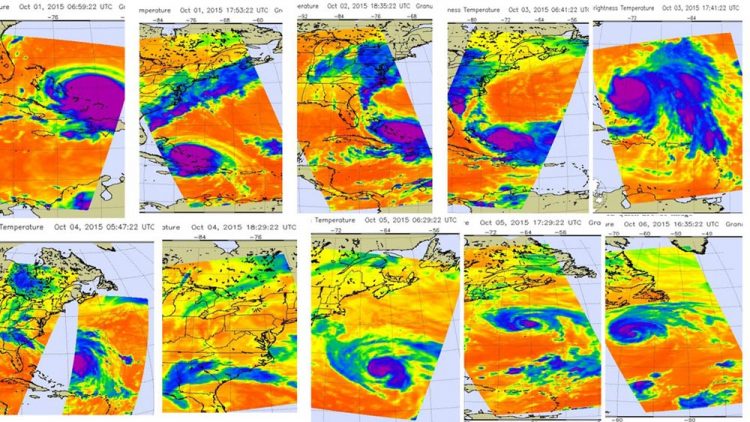NASA provides an infrared look at Hurricane Joaquin over time

This series of infrared images of Hurricane Joaquin from Oct. 1-6 show the development and movement of the storm, and its moisture stream into South Carolina. Credits: NASA JPL/Ed Olsen
The Atmospheric Infrared Sounder or AIRS instrument flies aboard NASA's Aqua satellite, which circles the Earth twice a day. AIRS gathers temperature data using infrared light, and took many images of Hurricane Joaquin from October 1 through October 6.
NASA put together a timeline of the infrared imagery showing the movement of Hurricane Joaquin and the plume of moisture connected to the Category Four storm that streamed over South Carolina.
The AIRS imagery showed Joaquin over the Bahamas on October 1 and then as it moved north, connected with another weather system that brought intense rainfall and both inland and coastal flooding to South Carolina.
That moisture plume is visible on the AIRS imagery from October 2 through October 4 where thunderstorms with very high, cold cloud tops made a line from the Bahamas to the U.S. mainland. Cloud top temperatures in the line of storms were as cold as or colder than -63 Fahrenheit/-53 Celsius. NASA research has shown that cloud tops that cold can produce heavy rain.
Cloud top temperatures around the eye of Hurricane Joaquin were even colder. Some cloud tops were in excess of -81F/-63C/210K.
Looking at Joaquin's Winds
As AIRS looked at cloud top temperatures another NASA instrument looked at surface wind speed in Joaquin. On October 7 at 12:00 a.m. EDT, the RapidScat instrument that flies aboard the International Space Station saw the sustained winds in Hurricane Joaquin. Strongest winds measured 40.5 meters per second (90.6 mph/145.8 kph) in all quadrants of the storm except the northeastern quadrant where winds were less intense. RapidScat measures wind speed at the surface which is always lower than speeds at higher altitude.
Where is Joaquin Now?
At 11 a.m. EDT (1500 UTC) on October 7, 2015 the center of Tropical Storm Joaquin was located near latitude 41.0 North and longitude 45.6 West. That's about 540 miles (870 km) southeast of Cape Race Newfoundland, Canada. Joaquin was moving toward the east-northeast near 35 mph (56 km/h) and the National Hurricane Center expects that motion to continue for the next day or two with some decrease in forward speed forecast on Friday.
Maximum sustained winds have decreased to near 70 mph (110 kph) and some weakening is forecast during the next 48 hours. Joaquin is forecast to become a large extratropical cyclone by Thursday.
Media Contact
All latest news from the category: Earth Sciences
Earth Sciences (also referred to as Geosciences), which deals with basic issues surrounding our planet, plays a vital role in the area of energy and raw materials supply.
Earth Sciences comprises subjects such as geology, geography, geological informatics, paleontology, mineralogy, petrography, crystallography, geophysics, geodesy, glaciology, cartography, photogrammetry, meteorology and seismology, early-warning systems, earthquake research and polar research.
Newest articles

High-energy-density aqueous battery based on halogen multi-electron transfer
Traditional non-aqueous lithium-ion batteries have a high energy density, but their safety is compromised due to the flammable organic electrolytes they utilize. Aqueous batteries use water as the solvent for…

First-ever combined heart pump and pig kidney transplant
…gives new hope to patient with terminal illness. Surgeons at NYU Langone Health performed the first-ever combined mechanical heart pump and gene-edited pig kidney transplant surgery in a 54-year-old woman…

Biophysics: Testing how well biomarkers work
LMU researchers have developed a method to determine how reliably target proteins can be labeled using super-resolution fluorescence microscopy. Modern microscopy techniques make it possible to examine the inner workings…





















